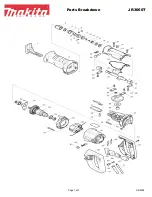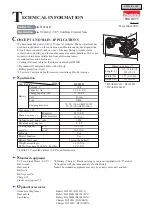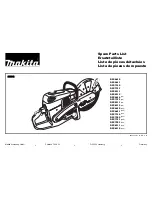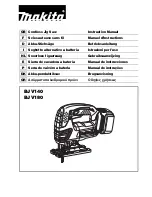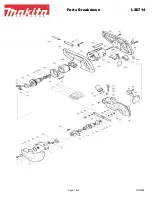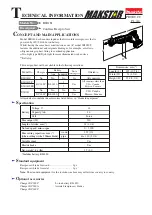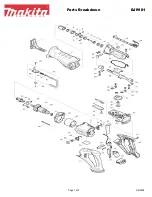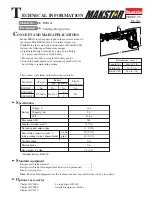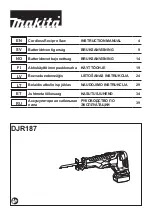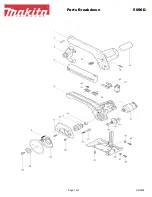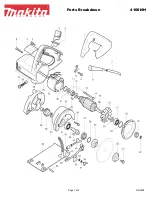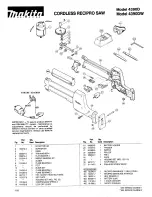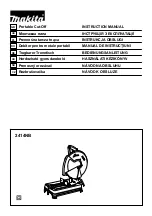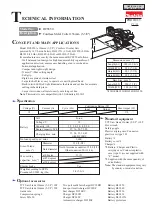
– 12 –
ANTI-KICKBACK PAWLS
– Prevents the workpiece
from being kicked upward or back toward the front of the
table saw by the spinning blade.
ARBOR
– The shaft on which the blade or dado is
mounted.
BEVEL CUT
– An angle cut made through the face of
the workpiece.
BLADE BEVEL SCALE
– Measures the angle the blade
is tilted when set for a bevel cut.
BLADE ELEVATION AND TILTING HANDWHEEL
–
Raises and lowers the blade or tilts the blade to angle
between 0
o
and 45
o
for bevel cuts.
BLADE GUARD
– Clear plastic cover that positions
itself over the blade while cutting.
COMPOUND CUT
– A simultaneous bevel and miter
cut.
CROSSCUT
– A cut made across the width of the
workpiece.
DADO
– Special cutting blades that are used to cut
grooves in a workpiece.
FEATHERBOARD
– When ripping a workpiece on your
table saw, this keeps it firmly and safely against the
rip fence. It also helps prevent chatter, gouging, and
dangerous kickback.
FREEHAND
– Performing a cut without using a rip
fence, miter gauge, hold down or other proper device to
prevent the workpiece from twisting during the cutting
operation.
GUM
– A sticky sap from wood products.
HEEL
– Misalignment of the blade.
JAMB NUT
– Nut used to lock another nut in place on a
threaded rod or bolt.
KERF
– The amount of material removed by the blade
cut.
KICKBACK
– Occurs when the saw blade binds in the
cut and violently thrusts the workpiece back toward the
operator.
MITER CUT
– An angle cut made across the width of
the workpiece.
MITER GAUGE
– A guide used for crosscutting
operations that slides in the table top channels (grooves)
located on either side of the blade. It helps make
accurate straight or angle crosscuts.
NON-THROUGH SAWING
- refers to any cut that does
not completely cut through the workpiece.
OVERLOAD RESET SWITCH
– Protects the motor if it
overloads during operation, provides a way to restart the
saw.
PUSH STICK
– Used to push workpieces when
performing ripping operations.
PUSH BLOCK
– Used for ripping operation when the
workpiece is too narrow to use a push stick. Always use a
push block for rip widths less than 2 in (50.8 mm).
RESAWING
- flipping material to make a cut the saw is
not capable of making in one pass.
Resawing IS NOT recommended.
REVOLUTIONS PER MINUTE (RPM)
– The number of
turns completed by a spinning object in one minute.
RIP FENCE
– A guide used for rip cutting which allows
the workpiece to cut straight.
RIPPING
– Cutting with the grain of the wood or along
the length of the workpiece.
RIVING KNIFE
– A metal piece of the guard assembly
located behind and moves with the blade. Slightly
thinner than the saw blade, it helps keep the kerf open
and prevents kickback.
SAW BLADE PATH
– The area of the workpiece or
table top directly in line with the travel of the blade or the
part of the workpiece that will be cut.
SET
– The distance between two saw blade tips, bent
outward in opposite directions to each other. The further
apart the tips are, the greater the set.
TABLE INSERT
– Insert that is removed from the table
to install / remove blades. When dado cutting, a dado
insert plate must be used.
THROUGH SAWING
– Making a cut completely
through the length or width of a workpiece.
WORKPIECE
– Material to be cut.
NOTE
: Blade guard assembly is removed for purposes
of illustration only.
GLOSSARY OF TERMS
Leading Edge
Kerf
Surface
Saw Blade Path
Trailing Edge
Workpiece
Direction of Workpiece
WARNING
!




























